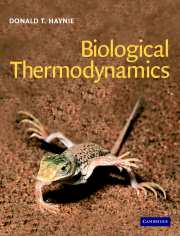Book contents
- Frontmatter
- Contents
- Preface
- Chapter 1 Energy transformation
- Chapter 2 The First Law of Thermodynamics
- Chapter 3 The Second Law of Thermodynamics
- Chapter 4 Gibbs free energy – theory
- Chapter 5 Gibbs free energy – applications
- Chapter 6 Statistical thermodynamics
- Chapter 7 Binding equilibria
- Chapter 8 Reaction kinetics
- Chapter 9 The frontier of biological thermodynamics
- Appendix A General references
- Appendix B Biocalorimetry
- Appendix C Useful tables
- Appendix D BASIC program for computing the intrinsic rate of amide hydrogen exchange from the backbone of a polypeptide
- Glossary
- Index of names
- Subject index
Chapter 9 - The frontier of biological thermodynamics
Published online by Cambridge University Press: 31 May 2010
- Frontmatter
- Contents
- Preface
- Chapter 1 Energy transformation
- Chapter 2 The First Law of Thermodynamics
- Chapter 3 The Second Law of Thermodynamics
- Chapter 4 Gibbs free energy – theory
- Chapter 5 Gibbs free energy – applications
- Chapter 6 Statistical thermodynamics
- Chapter 7 Binding equilibria
- Chapter 8 Reaction kinetics
- Chapter 9 The frontier of biological thermodynamics
- Appendix A General references
- Appendix B Biocalorimetry
- Appendix C Useful tables
- Appendix D BASIC program for computing the intrinsic rate of amide hydrogen exchange from the backbone of a polypeptide
- Glossary
- Index of names
- Subject index
Summary
Introduction
Thus far this book has principally been concerned with fairly well established aspects of energy transformation in living organisms, the macromolecules they're made of, and the environments in which living things flourish. Much of the discussion has had a decidedly practical slant to it, in order to show how thermodynamic and kinetic concepts can be useful in today's biochemistry laboratory. In the present chapter, we change our tack and set sail for waters less well charted. The exploration will aim to locate the material covered thus far in the broader scheme of things, and also to see how the development of topics of considerable current interest must conform to the strictures of the laws of thermodynamics. Our course might prove to be somewhat off the mark, as the questions addressed here are speculative; often no right answer is known. But the journey will nevertheless prove worth the effort, as it will show what a lively subject biological thermodynamics is and draw attention to a few of the areas where there is still much work to be done. Throughout the chapter, we shall bear in mind a program proposed over a century ago by the great British physicist Lord Kelvin (eponym of the absolute temperature scale; he lived 1824–1907); to explain all phenomena of the world, both natural and manmade, in terms of energy transformations.
What is energy?
Many students find the concept of energy difficult to grasp.
- Type
- Chapter
- Information
- Biological Thermodynamics , pp. 293 - 330Publisher: Cambridge University PressPrint publication year: 2001
- 2
- Cited by



